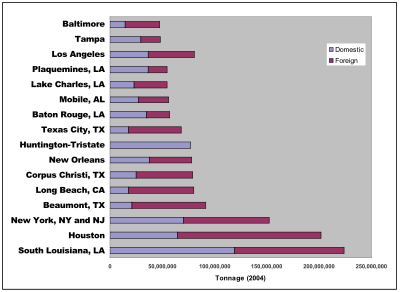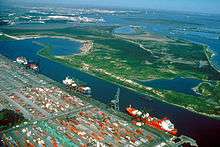Port of Houston
| Port of Houston | |
|---|---|
|
Logo of the Port of Houston Authority | |
| Location | |
| Country | United States |
| Location | Houston (Texas, USA) |
| Details | |
| Operated by | Port of Houston Authority |
| Owned by | City of Houston |
| Type of harbor | Artificial / natural |
| Number of cargo container terminals | 2 |
| Number of major general cargo terminals | 5 |
| Statistics | |
| Annual cargo tonnage | 212 million (2006)[1] |
| Annual container volume | 1.6 million TEUs (2006)[1] |
| Annual revenue | US$168 million (2006)[1] |
| Net income | US$42 million (2006)[1] |
| Economic value | US$118 billion (2006)[1] |
| Attributable jobs | 785,000 (2006)[1] |
| Draft depth | 45 feet |
|
Website http://www.portofhouston.com | |
The Port of Houston is a port in Houston, Texas, the fourth-largest city in the United States. The port is a 25-mile-long complex of diversified public and private facilities located a few hours' sailing time from the Gulf of Mexico. It is the busiest port in the United States in terms of foreign tonnage, second-busiest in the United States in terms of overall tonnage,[2] and thirteenth-busiest in the world. Though originally the port's terminals were primarily within the Houston city limits, the port has expanded to such a degree that today it has facilities in multiple communities in the surrounding area. In particular the port's busiest terminal, the Barbours Cut Terminal, is located in Morgan's Point.
The Port of Houston is a cooperative entity consisting of both the port authority, which operates the major terminals along the Houston Ship Channel, and more than 150 private companies situated along Buffalo Bayou and Galveston Bay.[3] Many petroleum corporations have built refineries along the channel where they are partially protected from the threat of major storms in the Gulf of Mexico. The petrochemical complex associated with the Port of Houston is one of the largest in the world.[4]
History

The original Port of Houston was located at the confluence of Buffalo Bayou and White Oak Bayou in downtown Houston by the University of Houston–Downtown. This area is called "Allen's Landing" and is now a park.[5] It is the birthplace of the City of Houston.
Shipping points grew at multiple locations on the Buffalo Bayou including the port of Harrisburg (now part of Houston) and the docks on the Allen Ranch. By the end of the 19th century Buffalo Bayou had become a major shipping channel with traffic beginning to rival Galveston.[6]
The citizens of Harris County approved creation of the modern port in 1909, believing that an inland port would better serve the region after the destructive Galveston Hurricane of 1900. President Woodrow Wilson officially opened the port to traffic as the World Port of Houston and Buffalo Bayou on November 10, 1914.[7] Early supporters would prove to be correct; the port has grown to be one of the world's largest, overtaking the nearby Port of Galveston in significance.
In 1977 the Port of Houston opened the Barbours Cut Terminal, Texas' first cargo container terminal, at Morgan's Point. This new terminal, in the Bay Area, quickly became the port's most important terminal.[8] The opening of the Bayport Terminal in 2006 further extended the port authority's reach outside the city of Houston.[9]
The port today

Approximately 215 million tons of cargo moved through the Port in 2005, most of which is petroleum related. The Port has two separate terminals dedicated to the handling of cargo containers: Barbours Cut (at Morgan's Point), and Bayport (in Pasadena, opened in October 2006). The Barbours Cut terminal was, in fact, the port's first terminal specifically designed for these shipments. Additional general cargo terminals include Turning Basin, Jacintoport, Woodhouse, and Care.[10]
The Port Authority offers a 90-minute free cruise aboard the M/V Sam Houston, details of which can be found on its website. Since the Houston Ship Channel is closed to recreational traffic, this is the only means by which the general public can view port operations, and thus the tours are highly popular.[11]
Most Volkswagen (and Audi) automobiles sold in North America pass through the port of Houston.[12]
The Port is operated by the Port of Houston Authority, an independent political subdivision of the State of Texas governed by a seven-member commission. The City of Houston and the Harris County Commissioners Court each appoint two commissioners; these two governmental entities also jointly appoint the chairman of the Port Commission. The Harris County Mayors and Councils Association and the City of Pasadena each appoint one commissioner. Daily operations are overseen by an Executive Director who serves at the will of the Commission.[13]
A renovation project for the Port's Turning Basin Terminal began in 2010 and is expected to take 10 years. The Turning Basin Terminal is a multipurpose complex with open wharves and 37 docks that are used for direct discharge and loading of breakbulk, containerized, project or heavy-lift cargoes.[14] The goal of the renovation is to accommodate the increase in the transportation of steel, which increased more than 3.1 million tons in the first nine months of 2011, up from 1.9 million tons over the same period in the previous year.[15]
Trade data
The Port of Houston is a major point of international trade for the United States. The following is the trade volume by world region reported by the Greater Houston Partnership as of 2006.[16]
- Europe 32%
- Latin America 22%
- Asia/Pacific Rim 15%
- North America 13%
- Middle East 7%
- Africa 12%
Foreign Trade Zone
The Port of Houston Authority manages Foreign Trade Zone (FTZ) No. 84, which includes many privately owned and port-owned sites located throughout Houston and Harris County, Texas. The Houston Zone offers users special benefits. For example, customs duties on imported goods entering the FTZ can be delayed until the cargo is removed from the zone. No duty is paid if the merchandise is exported directly from the zone.[17]
The following Sub Zones are a part of The Port of Houston FTZ No. 84:[18]
- 84E Gulf Coast Maritime
- 84F Valero Refining
- 84H Shaffer, Inc.
- 84I Tuboscope Vetco Int'l
- 84J Shell Oil Co.
- 84K Dril-Quip
- 84L Tadiran Microwave Networks
- 84M Hydril USA Manufacturing LLC
- 84N Pasadena Refining System, Inc.
- 84O EXXON Mobil
- 84P Houston Refining LP
- 84Q Equistar Chemicals
- 84R Michelin North America, Inc.
List of firsts
Despite being one of the youngest major ports in the world (the port reached its 100th birthday in 2014) it has already racked up an impressive list of firsts.[19]
Notable firsts include:
- First port to be built with federal funds and local matching funds, thus guaranteeing local support (every port since 1930 has had a local match requirement)
- First direct shipment of cotton to Europe (November 1919 via the M/V Merry Mount)
- First double-stack container train (1981)
- When the Baytown Tunnel was removed in 1997 to allow deepening and widening of the Houston Ship Channel (it was replaced by the Fred Hartman Bridge), it was the largest tunnel so removed (35' diameter by 1,041' length) without closing the channel, losing time due to accidents, or impacting the navigational safety of the port.
- First port to conduct air emissions testing of its off-road equipment (2000)
- First port to meet ISO 14001 standards for environmental excellence (2002), and the first port to be recertified to ISO 14001 standards (2004)
In 1968 Texas historian Marilyn McAdams Sibley published The Port of Houston: A History.[20]
See also
Notes
- 1 2 3 4 5 6 "PHA and Bond Fast Facts". Port of Houston Authority. Retrieved January 26, 2010.
- ↑ Collier, Kiah (May 3, 2013). "Houston has the busiest seaport in the U.S.". Houston Chronicle. Retrieved October 17, 2014.
- ↑ "Overview". Port of Houston Authority. Retrieved February 1, 2010.
- ↑ Weisman, Alan (2008). The World Without Us. New York: Macmillan. p. 166. ISBN 0-312-34729-4.
The industrial megaplex that begins on the east side of Houston and continues uninterrupted to the Gulf of Mexico, 50 miles away, is the largest concentration of petroleum refineries, petrochemical companies, and storage structures on Earth.
- ↑ Cartwright, Gary (July 1978). "On the Waterfront". Texas Monthly. p. 88.
- ↑ Houston Ship Channel from the Handbook of Texas Online. Retrieved February 1, 2010. Texas State Historical Association.
- ↑ "WELCOME TO PASADENA, TEXAS !". Pasadena Chamber of Commerce. Retrieved September 12, 2009.
- ↑ Cartwright, Gary (July 1978). "On the Waterfront". Texas Monthly. p. 161–162.
- ↑ "Bayport Terminal Progress". Port of Houston Authority. Retrieved February 1, 2010.
- ↑ "Maritime Operations". Port of Houston.
- ↑ Port of Houston magazine. Vol. 39. Harris County Houston Ship Channel Navigation District, Port of Houston Authority. 1997. Missing or empty
|title=(help) - ↑ "Factbox: Five facts about the Port of Houston". Reuters. December 13, 2009.
- ↑ "Administration: The Port of Houston Authority Commissioners". Port of Houston Authority. Retrieved February 1, 2010.
- ↑ The Port of Houston
- ↑ The Houston Chronicle
- ↑ 2006 Seaborne Trade with the World "Houston: Open for Business: Houston Highlights" Check
|url=value (help). Greater Houston Partnership. Retrieved February 1, 2010. - ↑ Port of Houston Authority Foreign Trade Zone "Foreign Trade Zone" Check
|url=value (help). Port of Houston Authority. Retrieved April 16, 2013. - ↑ International Trade Administration List of Foreign-Trade Zones by State "List of Foreign-Trade Zones by State" Check
|url=value (help). International Trade Administration. Retrieved April 16, 2013. - ↑ "Firsts" (PDF). Port of Houston.
- ↑ "Books by Marilyn McAdams Sibley". amazon.com. Retrieved September 26, 2010.
External links
| Wikimedia Commons has media related to Port of Houston. |
- Port of Houston Official Website
- Port of Houston Facts
- City of Pasadena, Texas Official Website
- View historical photographs of Houston and the Port at the University of Houston Digital Library
Coordinates: 29°36′40″N 95°01′18″W / 29.6111°N 95.0217°W



